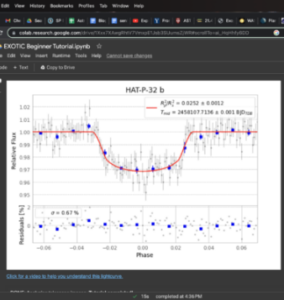Week 4: EXOTIC
April 25, 2023
Welcome back to my blog! This week I was preparing for my research into WASP-31 B by familiarizing myself with NASA’s EXOTIC Software. EXOTIC stands for EXOplanet Transit Interpretation Code, and it basically converts the raw data from telescopes about the relative brightness of stars over a certain period of time into pictures that astronomers can analyze. This is an example of some of the code it uses:

Here are some of the images I analyzed from EXOTIC:

I ran the code with data from a few practice planets with more information on them to make sure I was correctly identifying both my target star and the comparison stars. The target star is the one that has a transiting planet while the comparison stars serve as a baseline of brightness to confirm the transit depth is actually from a planet and not a passing dust cloud. Then I finalized the data and converted it into a light curve that turned out like this for one of my example planets HAT-P-32:

I then learned what each component of the light curve means in context.
This is an artistic rendering of the planet if you are curious:

The final product of EXOTIC is a file with all the analyzed information converted into python which can be uploaded to the AAVSO (American Association of Variable Star Observers) website and added to the archive database. Next week, I will be taking what I learned and applying it to develop the light curve for WASP-31 b. Thanks for reading my blog!
